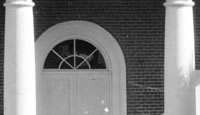| Construction |
Herring
Hall was built in 1903 for $6,675, $5,000 of which was donated
by the Copper Queen Mining Company. The gift was arranged
by Colonel William Herring, legal counsel for the company.
It is the second oldest building standing on the University
of Arizona Campus. Understanding Herring Hall’s history
as a functional, utilitarian, and flexible interior space
on the campus was important in creating an appropriate response
to the needs of the College of Agriculture and Life Sciences
while maintaining the historic integrity of the building.
The building has seen many uses throughout the years. It has
responded to a need of the campus for auxiliary or utilitarian
spaces for a variety of functions. Originally built as the
Men’s Gymnasium (1903 – 1925), Herring Hall subsequently
housed the Women’s Physical Education program (1925
– 1937), the Drama Department (1937 – 1956), the
School of Journalism and the Radio/TV Bureau (1956 –
1970), and the Landscape Architecture Program (1970 –
1991). In the last decade the basement has been used by College
of Agriculture and Life Sciences Graduate Students, and the
remainder for storage purposes.
The
first floor was constructed for an open gymnasium which remains
the character- defining interior space. The basement was used
for lockers and showers. In 1906, a balcony was added to the
interior volume of the first floor at the west end. In 1925,
an addition was constructed on the east end of the building.
This was ultimately removed for the construction of the Marley
Building in 1988. In 1956, the building underwent considerable
interior renovations for the Radio and TV Bureau. A tower
was constructed to the east of the building, where it remained
until the late 1980’s. The Landscape Architecture Program
made few changes in the building, other than filling in the
balcony space for offices. The basement was modified in 1984
by improving the existing stair access and adding an additional
external stair access for fire code reasons. |
|
| Architecture |
Herring
Hall is a small, Roman Revival building constructed of red
brick. The four Doric columns of the west-facing front are
of concrete with rough stone bases and capitals, unadorned,
painted white, and supporting an entablature and pediment,
which is also painted white. The entablature wraps the entire
building. The well-proportioned building measures 40’
x 80,’ and rises to 30’ under the 5:12 roof pitch.
The wooden roof deck is finished in composite zinc/lead sheeting.
On the south side is a small rotunda approximately 14’
in diameter. The entrance has a solid arch, a transom, and
standard doors (replaced with this building rehabilitation
project). It is flanked by heavy, concrete-framed, wood, double-hung
windows. There are segmental arched openings on the sides
of the building with 6/6 wood, double-hung windows. A volcanic
stone base supports the flanking walls. The brickwork on the
building is common bond with seven stretcher courses per header
course. |
|
| Herring
Hall Architect |
David
Holmes (1874-1967) was born in St. Louis and was influenced
by the work of the turn of the century architects making their
mark in Midwestern cities. Holmes moved to Tucson in 1898
to take a teaching position in manual training and mechanical
drawing at the Territorial University (later the University
of Arizona) School of Mines. Teaching and securing equipment
for the University’s first shop building dominated Holmes’
first few years until he was requested to design a gymnasium
building in 1903, purportedly to save the cost of hiring an
out-of-town architect. Eventually named Herring Hall, this
modified temple structure was designed in the Roman Revival
style to represent a sense of permanence to the fledgling
university campus. During subsequent years, Holmes took on
new responsibilities, including building supervisor for the
University’s growing campus, interim university president,
as well as architect for independent commissions, such as
the Desert Botanical Laboratory on Tumamoc Hill, built in
1903.
The
architectural firm of Holmes and Holmes was responsible for
over 30 buildings in the course of its eight-year tenure in
Tucson. The projects represented the range of functions necessary
for the expanding town including residences, commercial blocks,
hotels, churches, hospitals, and educational buildings, requiring
versatility matched by no other Tucson architect at that time.
At
a time when Tucson was the largest city in Arizona and New
Mexico, and many of its large buildings were designed by out-of-town
architects, the firm of Holmes and Holmes provided the competency
necessary to shift that trend to local architects. Holmes’
significance also lies in his direct response to the hot,
arid climate at a time of imported, and inappropriate, stylistic
themes. Holmes’ work adhered to a functional philosophy
of architecture, characterized by craftsmanship and a simplicity
of expression without the excesses of ornamentation; not unlike
the early 20th century Tucson it represented. |
|
| Contemporary
Occupants of Herring Hall |
The
Campus Herbarium
A
herbarium is a scientific museum housing preserved specimens
of plants, mostly as pressed specimens mounted on special
sheets of stiff archival paper. The collections of herbaria
constitute the basis for all work in plant taxonomy; they
are also used extensively by ecologists, biogeographers, natural
resource scientists, anthropologists, and pharmacologists.
The
University of Arizona Herbarium consists of two major collections;
the vascular plant collection and the mycological collection.
The Vascular Plant Herbarium was established by James Toumey
in 1890, the year before the University opened its doors to
students, and 13 years prior to the construction of Herring
Hall. The Herbarium now houses over 450,000 specimens, constituting
the largest collection of plants from the southwestern United
States and northwestern Mexico. Between 2,000 and 2,500 persons
visit the Herbarium every year, including students, associated
scientists, agency personnel, and the general public. Each
year faculty and staff at the Herbarium provide thousands
of identifications of plants for county agents, researchers,
ranchers, farmers, and many state residents.
The
Herbarium, housed in the basement of the Shantz building for
the past 42 years, had outgrown its available space. The renovation
of Herring Hall by the College of Agriculture and Life Sciences
not only unites one of the University’s oldest institutions
with one of its most historic buildings, but also provides
a home that will permit the Herbarium to continue to grow
and serve the University and state for the next 100 years.
Until
about 1945 the mycological collections were a part of the
general herbarium. Some time after Dr. Paul D. Keener joined
the faculty as mycologist, he moved 17 cases containing fungal
specimens to a back room of Forbes 104, Keener’s office
when he died in 1966. Dr. Robert L. Gilbertson joined the
faculty in 1967 and in 1971 moved the Mycological Herbarium
to its location in Shantz 101. By 2004 the Mycological Herbarium
has grown to over 40,000 accessioned collections, the majority
collected by Dr. Gilbertson and his students. Other important
collections in the Mycological Herbarium are the rust fungi
collections of Dr. George B. Cummins.
Visit the Campus Herbarium website at cals.arizona.edu/herbarium.
The
Campus Arboretum
The
Mission of the University of Arizona Campus Arboretum is to
preserve, manage, enhance, and expand a vital collection of
plants in an active, urban Sonoran Desert setting. The Campus
Arboretum showcases the historic, scientific, aesthetic, environmental,
economical, conservation, and educational value of these plants
within the larger Tucson urban forest and the American Southwest.
In
the 1800's cactus and creosote surrounded Tucson, Arizona.
When the University of Arizona was established as the state's
land-grant institution, ornamental trees, shrubs, and cacti
were planted to beautify the grounds (and cut down on the
dust!). Today's campus holds over 500 individual tree species.
Ever
since 19th century UA faculty member Robert Forbes planted
the olive trees that still shade the older campus areas, plants
of all kinds have enriched campus life. The University of
Arizona holds a truly unique collection of plants from arid
and semi-arid climates around the world. Many campus trees
are the largest specimens in Arizona and have been designated
as Great Trees of Arizona. The UA’s Heritage Trees are
stately links to the University's past. Several are unique
to the entire Southwest; a few were the first of their kinds
to be planted in the Western Hemisphere. In September 2002,
the UA Campus Arboretum was officially dedicated and accepted
as a member of the American Association of Botanical Gardens
and Arboreta.
The
Campus Arboretum administrative office is located on the first
floor of Herring Hall immediately adjacent to the front entrance.
Visit the Campus Arboretum website at arboretum.arizona.edu. |
|
| Credits/Sources |
University
of Arizona West Campus Historic District Nomination Form,
1986
Herring Hall Feasibility Study, 1999. Burns and Wald-Hopkins
Architects
David Holmes, a Brief Biography, 1999.
R. Brooks Jeffery, Coordinator, Preservation Studies, College
of Architecture and Landscape Architecture
Steven P. McLaughlin, Director, Campus Herbarium
Elizabeth Davison, Director, Campus Arboretum |
|
home | history |
renovation | dedication
| photos | video | |


